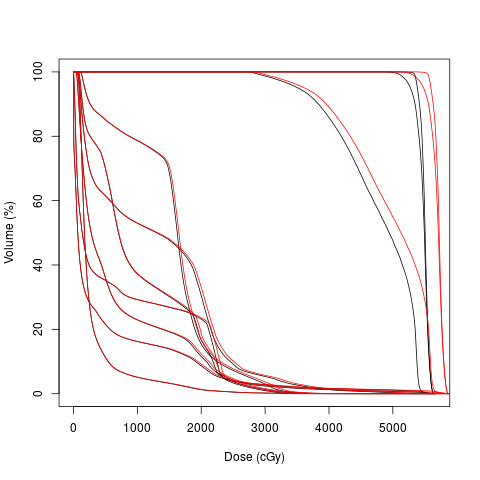Supported by Dr. Osamu Ogasawara and  providing providing  . . |
|
Last data update: 2014.03.03 |
Linear Quadratic Extrapolated (LQE) Dose ConversionDescriptionThis function and its associated methods calculate LQE-weighted dose(s) for a given Usage
## S4 method for signature 'DVH,numeric'
LQE(x, aB, fractions = NULL, N = NULL, dose.units = c("cGy", "Gy"))
## S4 method for signature 'DVH.list,numeric'
LQE(x, aB, fractions = NULL, N = NULL, dose.units = NULL)
## S4 method for signature 'numeric,numeric'
LQE(x, aB, fractions = NULL, N = NULL, dose.units = c("cGy", "Gy"))
Arguments
ValueReturns a Author(s)Reid F. Thompson (reid.thompson@gmail.com) ReferencesBarendsen, G.W. (1982) Dose fractionation, dose-rate and iso-effect relationships for normal-tissue response. Int J Radiat Oncol Biol Phys 8(11):1981-1997. See Also
Examples# 5x 300cGy == 9x 200cGy (1800cGy isoeffective dose) LQE(1500, aB=3, fractions=c(300, 200), dose.units="cGy") LQE(15, aB=3, N=c(5, 9), dose.units="Gy") LQE(18, aB=3, fractions=c(2, 3), dose.units="Gy") # Multiple simultaneous numerical queries LQE(c(4500, 5400), aB=3, fractions=c(300, 200), dose.units="cGy") # DVH processing LQE(janedoe[["LIVER"]],aB=3,fractions=200,dose.units="cGy") # DVH list processing (default dose.units is "cGy") plot(janedoe) plot(LQE(janedoe,aB=3,fractions=200),col="red",new=FALSE) Results
R version 3.3.1 (2016-06-21) -- "Bug in Your Hair"
Copyright (C) 2016 The R Foundation for Statistical Computing
Platform: x86_64-pc-linux-gnu (64-bit)
R is free software and comes with ABSOLUTELY NO WARRANTY.
You are welcome to redistribute it under certain conditions.
Type 'license()' or 'licence()' for distribution details.
R is a collaborative project with many contributors.
Type 'contributors()' for more information and
'citation()' on how to cite R or R packages in publications.
Type 'demo()' for some demos, 'help()' for on-line help, or
'help.start()' for an HTML browser interface to help.
Type 'q()' to quit R.
> library(RadOnc)
Loading required package: rgl
Loading required package: geometry
Loading required package: magic
Loading required package: abind
Loading required package: oro.dicom
oro.dicom: Rigorous - DICOM Input / Output (version = 0.5.0)
Loading required package: ptinpoly
Loading required package: misc3d
> png(filename="/home/ddbj/snapshot/RGM3/R_CC/result/RadOnc/LQE.Rd_%03d_medium.png", width=480, height=480)
> ### Name: LQE
> ### Title: Linear Quadratic Extrapolated (LQE) Dose Conversion
> ### Aliases: LQE LQE-methods LQE,ANY,missing-method
> ### LQE,DVH.list,numeric-method LQE,DVH,numeric-method
> ### LQE,numeric,numeric-method
> ### Keywords: methods manip
>
> ### ** Examples
>
> # 5x 300cGy == 9x 200cGy (1800cGy isoeffective dose)
> LQE(1500, aB=3, fractions=c(300, 200), dose.units="cGy")
[1] 1800
> LQE(15, aB=3, N=c(5, 9), dose.units="Gy")
[1] 18
> LQE(18, aB=3, fractions=c(2, 3), dose.units="Gy")
[1] 15
>
> # Multiple simultaneous numerical queries
> LQE(c(4500, 5400), aB=3, fractions=c(300, 200), dose.units="cGy")
[1] 5400 6480
>
> # DVH processing
> LQE(janedoe[["LIVER"]],aB=3,fractions=200,dose.units="cGy")
[1] "Structure: LIVER (1635.9cc), Dose: 42.72-5862.84cGy (5720cGy prescribed), DVH: cumulative, Volume: relative"
>
> # DVH list processing (default dose.units is "cGy")
> plot(janedoe)
> plot(LQE(janedoe,aB=3,fractions=200),col="red",new=FALSE)
>
>
>
>
>
> dev.off()
null device
1
>
|
